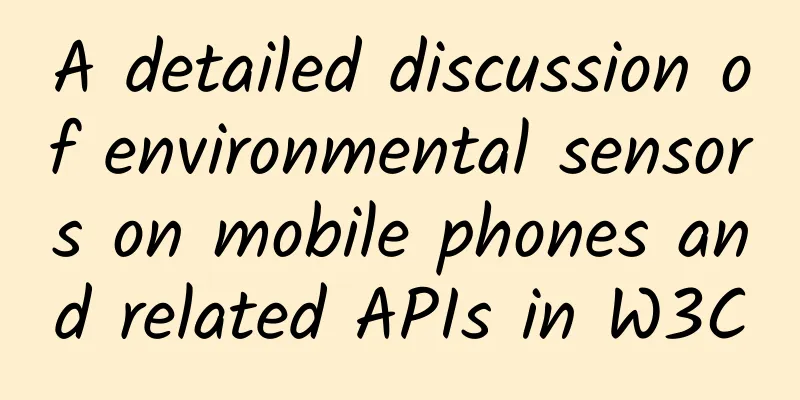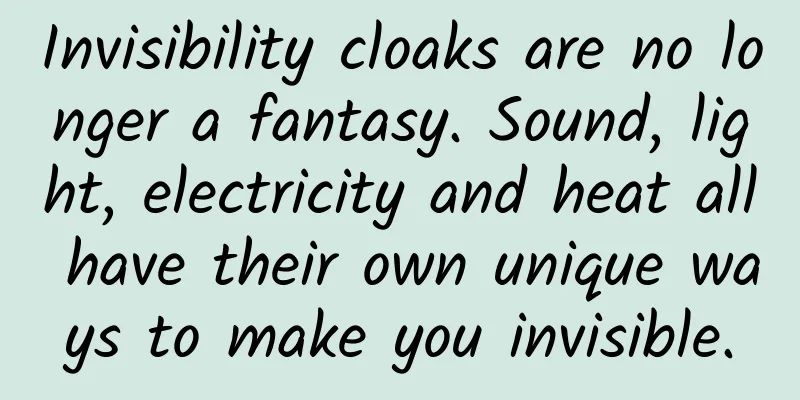A detailed discussion of environmental sensors on mobile phones and related APIs in W3C

|
Environmental sensors on mobile phones generally include air pressure sensors, temperature sensors, humidity sensors, light sensors, sound sensors, and distance sensors. The air pressure sensor can determine the altitude of the current location of the mobile phone by measuring air pressure, which can improve the accuracy of GPS positioning. It is equipped on the Samsung Galaxy Nexus. The temperature sensor is used to measure the temperature and determine whether the current environment is comfortable. On the other hand, it can also monitor whether the internal temperature of the mobile phone is abnormal. The more common ones are light sensors and distance sensors, which are almost standard for smartphones and are generally designed to be located near the earpiece on the top of the front of the mobile phone. Proximity sensor and ambient light sensor The distance sensor consists of an infrared LED light and an infrared radiation light detector. The main reason why the distance sensor is located near the handset of the mobile phone is that when the mobile phone is close to the ear, the system knows through the distance sensor that the user is on the phone, and then turns off the display to prevent the user from affecting the call due to misoperation. The distance sensor uses the principle of "time of flight method" to detect the distance between the object and the object. It emits a very short light pulse and calculates the time it takes to be reflected by the object. The light sensor of the mobile phone, also known as the ambient light sensor, can sense the light conditions around the device. The mobile phone operating system uses the data from the light sensor to automatically adjust the brightness of the display screen - when the ambient brightness is high, the display brightness will be increased accordingly; when the ambient brightness is low, the display brightness will be reduced accordingly. Automatic brightness ensures the screen reading experience of the mobile phone in different environments, and reduces power consumption, maximizing the working time of the device. Proximity API Proximity API is an independent API for distance sensors in the W3C specification, which provides Web developers with distance information between devices and objects. Based on the distance information of the device, we can do more than just turn off the screen during a call. When playing music on a mobile web page, I can pause the music without touching the screen. I can also control the character's advance and retreat in a mobile web game like a magic trick... The API defines two device events: deviceproximity and userproximity. The former provides information about the distance between the device and the object, while the latter determines whether an object is approaching. Let's first check whether the current browser supports it:
The deviceproximity event provides three properties: value, min, and max. Value represents the distance between the device and the object in front of the device, and min and max represent the distance range that the sensor can detect, in centimeters.
The userproximity event has an attribute: near. It is a Boolean value that indicates whether there is an object approaching the device. The default value is false. The range it detects is also the detection distance range of deviceproximity.
Through the above two events, we can perceive the distance information between the device and the object. By binding the control events of web page elements, we can realize gesture interaction on the web page without touching the screen. Ambient Light API Ambient Light API, an independent API for ambient light sensors in the W3C specification, provides Web developers with the numerical value of the ambient light intensity sensed by the device. The API initially provided two events to monitor the ambient light conditions of the device: devicelight and lightlevel. The former returns the numerical value of the ambient light intensity in lux units; the latter describes the current ambient light intensity level - dim, normal, and bright. In the latest W3C specification, the lightlevel event has been removed. In fact, we can completely define the light intensity level through devicelight ourselves.
The devicelight event has only one value attribute, and different test devices may return different values, ranging from 0 to infinity. Based on this ambient light intensity, we can automatically switch to a night theme on the web page to try to reduce user eye fatigue caused by web page reading. By observing the changes in this value in different environments, we set two dividing points for theme changes: 50lux and 10000lux, so we have:
Not only that, in web games, we can match different theme scenes as the game background according to the current ambient light intensity to enhance the environmental atmosphere and strengthen the sense of reality of the game. compatibility Unfortunately, among desktop and mobile browsers, only Firefox currently supports the Proximity API and Ambient Light API, and the desktop version's support for the Ambient Light API is limited to Mac OS X systems. [Figure 1.2 Proximity API support] [Figure 1.3 Ambient Light API support] |
<<: Introduction to frequently used iOS third-party libraries and XCode plug-ins
>>: Brief analysis, sharing of the process of decompiling Android APK
Recommend
Practical case analysis: How to deeply understand user growth
The concept of User Growth (UG) originated from t...
Industrial design always shines; Chinese design leads the trend of home appliances in Europe and America
The change in the iPhone 6's appearance has o...
Astronomical wonders: The Perseverance rover captured a clear and beautiful solar eclipse on Mars!
A solar eclipse on Earth is caused by the Earth&#...
Chrome extension Safe Browsing service can prevent homepage tampering
Google recently announced that it will expand the...
A complete analysis of the Toutiao search account setup and delivery ideas
As a new search platform launched this year, Tout...
How to be an elegant and football-savvy sister/brother when cheering for the women's football team to win the championship?
Mixed Knowledge Specially designed to cure confus...
"Nation, world" This is the mission of the Red Flag and the expectation of the Chinese people
In domestic shopping malls, a wide variety of imp...
This message is very important! Did you receive it?
It’s the annual season for eating wild mushrooms ...
"Sun Wukong" of the cell world, how to release it from under the "Five Elements Mountain"?
Produced by: Science Popularization China Author:...
Channel promotion: All the things you don’t know are here
He used to work for a large Internet company, whe...
up to date! Data rankings of 56 information flow advertising media platforms!
The following is the latest traffic rankings of 5...
Lighthouse inheritance | Wu Mengchao: A doctor with a heart of compassion and a heart of bravery
He performed the first liver cancer middle lobect...
Case summary: How can an offline store attract 2,000+ people in two hours?
Seeing this title, I believe many people are a li...
An inconspicuous cooking habit can cause osteoporosis in the whole family
When it comes to osteoporosis, the first thing ma...





![[Guangming Museum Drawing] There are some tips for “drawing fish”: taking the coral reef fish of the South China Sea as an example](/upload/images/67f224062f0fb.webp)



